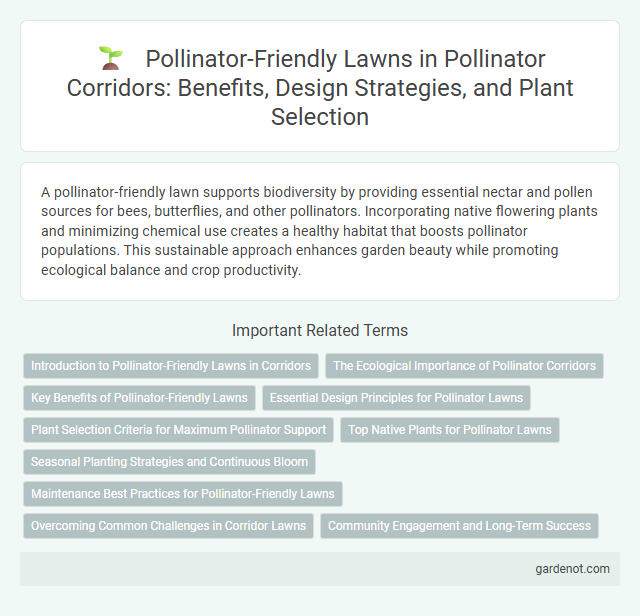A pollinator-friendly lawn supports biodiversity by providing essential nectar and pollen sources for bees, butterflies, and other pollinators. Incorporating native flowering plants and minimizing chemical use creates a healthy habitat that boosts pollinator populations. This sustainable approach enhances garden beauty while promoting ecological balance and crop productivity.
Introduction to Pollinator-Friendly Lawns in Corridors
Pollinator-friendly lawns within corridors provide essential habitats that support the lifecycle of bees, butterflies, and other pollinating insects. These lawns incorporate native flowering plants and reduced chemical use, enhancing biodiversity and ecosystem resilience. Establishing such lawns in corridors strengthens pollinator networks, vital for agricultural productivity and environmental health.
The Ecological Importance of Pollinator Corridors
Pollinator corridors enhance biodiversity by providing essential habitat and food sources for bees, butterflies, and other pollinators within pollinator-friendly lawns. These corridors facilitate gene flow between fragmented plant populations, supporting ecosystem resilience and crop pollination. Establishing interconnected pollinator corridors promotes ecological balance and sustains pollinator species critical for maintaining global food security.
Key Benefits of Pollinator-Friendly Lawns
Pollinator-friendly lawns provide essential habitats for bees, butterflies, and other pollinators, enhancing biodiversity in urban and suburban environments. These lawns support native plant species that offer nectar and pollen, boosting pollinator health and agricultural productivity. Incorporating pollinator-friendly practices reduces the need for pesticides and fertilizers, promoting a sustainable and eco-friendly landscape.
Essential Design Principles for Pollinator Lawns
Pollinator-friendly lawns incorporate essential design principles such as selecting native, nectar-rich flowering plants and creating diverse plant structures to support various pollinator species. Maintaining reduced mowing schedules preserves bloom availability and nesting habitats, enhancing pollinator activity throughout the season. Integrating organic soil management practices improves soil health, fostering a robust environment for pollinator populations.
Plant Selection Criteria for Maximum Pollinator Support
Selecting plants with high nectar and pollen production, native species adaptability, and extended blooming periods ensures maximum support for pollinators in pollinator-friendly lawns. Emphasizing diverse plant structures and colors attracts a variety of pollinator species, boosting biodiversity and ecological resilience. Prioritizing drought-tolerant and pest-resistant plants reduces maintenance while sustaining continuous food sources for bees, butterflies, and other pollinating insects.
Top Native Plants for Pollinator Lawns
Top native plants for pollinator-friendly lawns include purple coneflower (Echinacea purpurea), black-eyed Susan (Rudbeckia hirta), and wild bergamot (Monarda fistulosa), all known for attracting bees, butterflies, and other pollinators. These species provide essential nectar and pollen sources throughout the growing season while supporting local biodiversity and enhancing habitat connectivity in pollinator corridors. Incorporating a diverse mix of native grasses and flowering plants promotes soil health, reduces maintenance needs, and sustains critical pollinator populations.
Seasonal Planting Strategies and Continuous Bloom
Seasonal planting strategies enhance pollinator-friendly lawns by ensuring a continuous bloom of native flowers throughout spring, summer, and fall, providing consistent nectar and pollen sources. Selecting diverse species with staggered flowering periods supports various pollinator species, including bees, butterflies, and hummingbirds, optimizing habitat quality and biodiversity. Incorporating native perennials, annuals, and shrubs tailored to regional climates promotes resilience and sustains pollinator populations year-round within corridor landscapes.
Maintenance Best Practices for Pollinator-Friendly Lawns
Maintaining a pollinator-friendly lawn requires regular practices such as mowing less frequently and at a higher height, which promotes native wildflowers and grasses that provide nectar and habitat for bees, butterflies, and other pollinators. Avoiding chemical pesticides and fertilizers reduces the risk of harming beneficial insects and supports a healthy ecosystem within the lawn. Incorporating diverse native plants and allowing patches of bare soil can enhance nesting opportunities and sustain pollinator populations effectively.
Overcoming Common Challenges in Corridor Lawns
Pollinator-friendly lawns in corridor designs face challenges such as soil compaction, limited native plant diversity, and pesticide exposure. Implementing diverse, native flowering plants and reducing chemical inputs enhance habitat quality and encourage pollinator activity. Regular maintenance practices like mowing height adjustments support healthy growth and biodiversity in these corridors.
Community Engagement and Long-Term Success
Creating a pollinator-friendly lawn involves active community engagement through workshops, local planting events, and educational campaigns that raise awareness about the importance of pollinators. Encouraging residents to incorporate native flowering plants and avoid pesticides fosters biodiversity and strengthens ecological networks within the corridor. Long-term success depends on sustained community participation, monitoring pollinator populations, and maintaining habitat connectivity to support diverse pollinator species year after year.
Pollinator-friendly lawn Infographic

 gardenot.com
gardenot.com